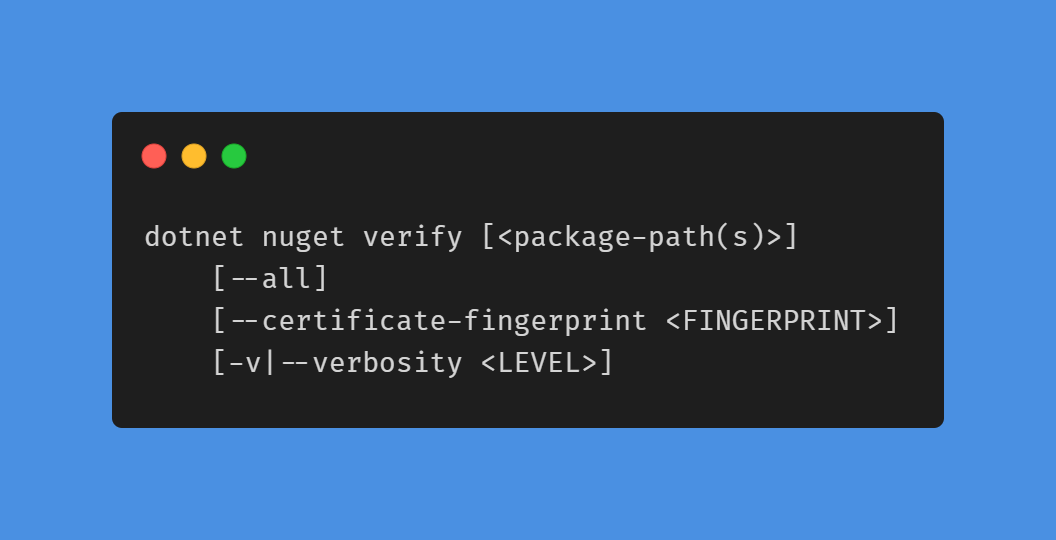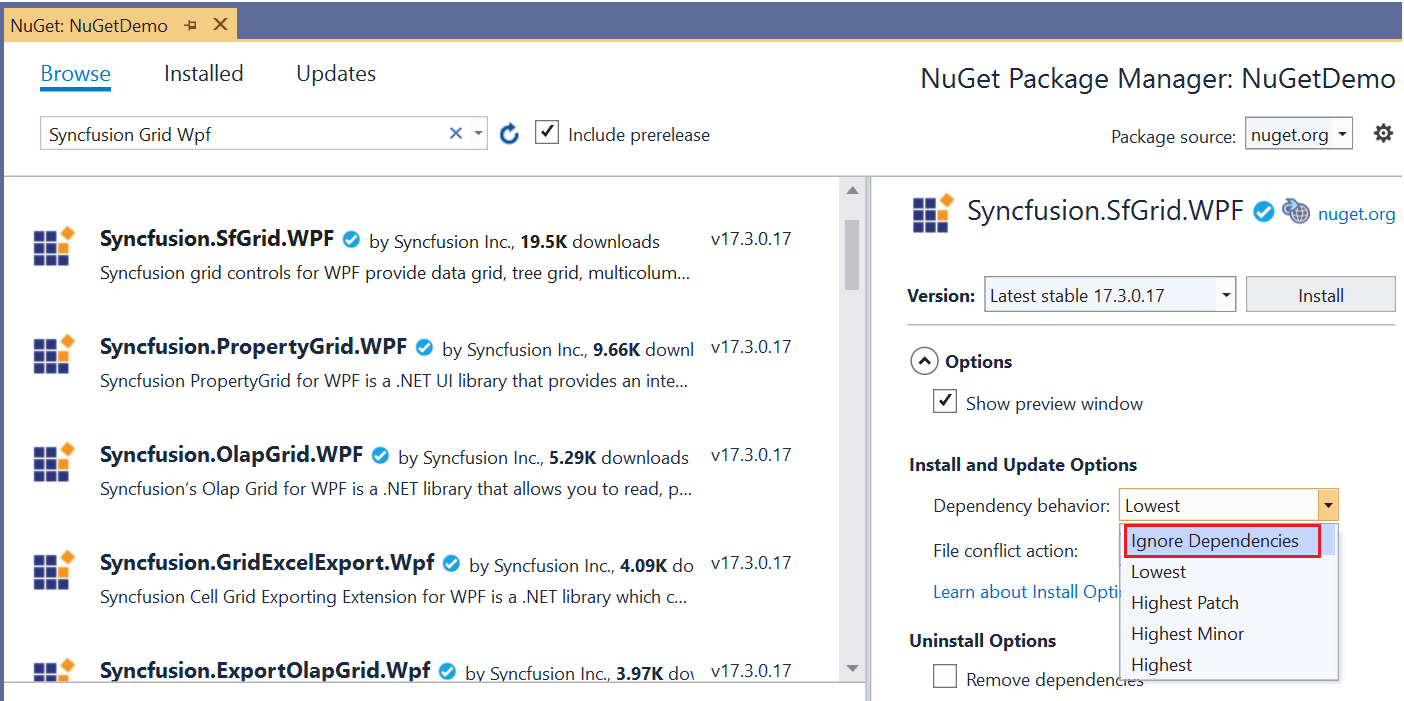- Install Nuget Package Dotnet Cli Commands
- Dotnet Cli Add Nuget Package
- Install Nuget Package Dotnet Cli Installer
- Dotnet Cli Nuget Source
Once you have signed up for a Gemfury account,you can upload and install NuGet packages.
To authenticate to GitHub Packages with the dotnet command-line interface (CLI), create a nuget.config file in your project directory specifying GitHub Packages as a source under packageSources for the dotnet CLI client. To use or install package manually, go to Tools- Options- NuGet Package Manager- Package Sources. Click the Add button, choose the Source, and don't forget to click 'Update' as it will update the folder location for your packages, edit your desired Name of your package source if.
Uploading packages
There are a few guides on the web about creating a NuGet package. Once you havethe package file, you can use the Dashboard, command line, or cURL to upload itto your Gemfury account.
Your secret Repository URL
The secret repository URL is the NuGet endpointfor your Gemfury account and packages. Do not share this URL to keepyour account private. Your Repo-URL has the following format:
Setting up Visual Studio with Gemfury
To install your packages, you’ll need to configure NuGet to access your Gemfuryrepository by performing the following steps:
- Go to Tools → NuGet Package Manager → Package Manager Settings
- Select NuGet Package Manager → Package Sources in the navigation tree
- Enter “Gemfury” into the Name field and your NuGet Repo-URL intothe Source field, and press Add
- (Optional) Use the arrow buttons to move the “Gemfury” source to the firstspot to prioritize your packages over the ones in the public repository.
Installing packages using Visual Studio
To install packages from your Gemfury repository, perform the following steps:
- Go to Project → Manage NuGet Packages
- In Package Source select the “Gemfury” entry
- Select desired package and specific version, then click
Install - After which,
Buildyour project. If needed, Visual Studio performs a restoreof NuGet packages as part of the build steps.
Using NuGet command line tool with Gemfury
Append the -Source option to your NuGet.exe commands toaccess your private packages in Gemfury:
List the current versions for your private packages:
Install a package:
Using dotnet command line tool with Gemfury
You may use the dotnet CLI tool to restore packages of an existing solutionor project.
To achieve this, execute the following command from either the solution orthe project directory:

Note, executing from a solution directory, will perform the restore in everyproject that is part of the solution.
You can add a private package from your private repository:
Or, remove a package from your project:
Configure Gemfury as a source in NuGet
Add as a source:
This will add your NuGet repo url in the user-specific list of package sources,which is available in all projects by that user.
You may learn more about managing NuGet sources from the official help page.
Configure Gemfury as a project specific source in NuGet
NuGet has support for custom config files, and may be used to configure projectspecific NuGet settings.
To add as a source specific to a project:
Install Nuget Package Dotnet Cli Commands
Where ProjectDir is the root directory of your project. Make sure the name ofthe config file is NuGet.Config.
You may learn more about this feature from the official help page.
βeta notes
Currently, Gemfury does not support NuGet’s search or pre-release capabilitiesvia the -Filter and -Prerelease options in the NuGet.exeor Package Manager Console. Please contact usif this limits your ability to use Gemfury with your project.
The .NET Core 2.0 CLI (dotnet.exe), works on all platforms (Windows, Mac, and Linux) and provides core NuGet features such as installing, restoring, and publishing packages.
- The dotnet provides direct integration with .NET Core project files (such as
.csproj), which is helpful in most scenarios. - It is also built directly for each platform and does not require you to install Mono.
Installation
- On developer computers, install the .NET Core SDK.
- For build servers, follow the instructions on Using .NET Core SDK and tools in Continuous Integration.
Commands
The dotnet CLI provides the following essential nuget.exe commands.
Dotnet Cli Add Nuget Package
Add
Adds a package reference to a project file.
Examples
Add Newtonsoft.Json NuGet package to a project.
Add a specific version of a package to a project.

Add a package using a specific NuGet source.
Remove
Removes package reference from a project file.
Examples
Removes Newtonsoft.Json NuGet package from a project in the current directory.
Restore
Restores the dependencies and tools of a project.
Examples
Restore dependencies and tools for the project in the current directory.
Restore dependencies and tools for the app1 project found in the given path.
Restore the dependencies and tools for the project in the current directory using the file path provided as the source.
Restore the dependencies and tools for the project in the current directory using the two file paths provided as sources.
Restore dependencies and tools for the project in the current directory and shows only minimal output.
Locals
Clears or lists local NuGet resources.
Install Nuget Package Dotnet Cli Installer
Examples
Displays the paths of all the local cache directories (http-cache directory, global-packages cache directory, and temporary cache directory).
Displays the path for the local http-cache directory.
Clears all files from all local cache directories (http-cache directory, global-packages cache directory, and temporary cache directory):
Clears all files in the local global-packages cache directory.
Clears all files in the local temporary cache directory.
Pack
Dotnet Cli Nuget Source

Packs the code into a NuGet package.
Examples
Pack the project in the current directory.
Pack the app1 project.
Pack the project in the current directory and place the resulting packages into the nupkgs folder.
Push
Pushes a package to the server and publishes it.
Examples
Pushes foo.nupkg to the default push source, specifying an API key:
Push foo.nupkg to the custom push source https://customsource, specifying an API key:
Pushes foo.nupkg to the default push source:
Pushes foo.symbols.nupkg to the default symbols source:
Pushes foo.nupkg to the default push source, specifying a 360-second timeout:
Pushes all .nupkg files in the current directory to the default push source:
Delete
Deletes or unlists a package from the server.
Examples
Deletes version 1.0 of package Microsoft.AspNetCore.Mvc:
Deletes version 1.0 of package Microsoft.AspNetCore.Mvc, not prompting user for credentials or other input:
